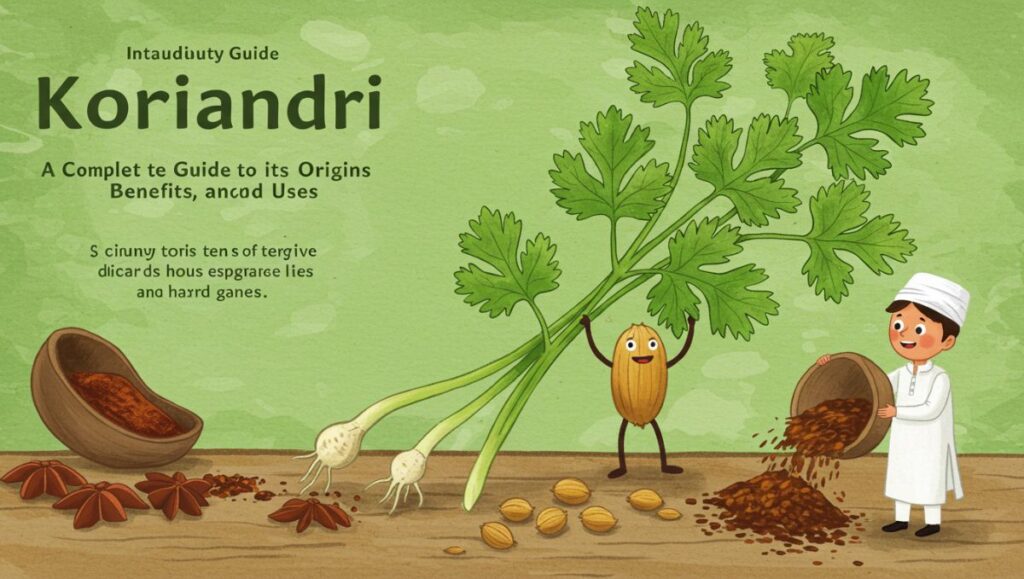Koriandri, more commonly known as coriander, is one of the oldest spices and herbs cultivated by humans. Its history stretches across continents, its seeds and leaves have flavored countless traditional dishes, and its medicinal properties have been valued in cultures for thousands of years. This article explores the fascinating world of koriandri, from its botanical background to its wide-ranging culinary and health applications.
Origins and Historical Significance
Ancient Roots
Koriandri traces its origins to the Mediterranean and Middle Eastern regions. Archaeological findings show coriander seeds were placed in the tombs of Egyptian pharaohs, symbolizing not only its culinary worth but also its spiritual significance.
The plant was also mentioned in Sanskrit texts, reflecting its importance in ancient Indian traditions. Roman and Greek civilizations used coriander extensively for both flavoring food and creating medicinal remedies.
Spread Across the World
With the expansion of trade routes, koriandri spread to Asia, Africa, and eventually the Americas. Every region adapted the herb and seed to suit its own cuisine. For example, in Latin America it became a key ingredient in salsas, while in India it evolved into a cornerstone of spice blends such as garam masala and curry powders.
Botanical Profile of Koriandri
Koriandri, scientifically known as Coriandrum sativum, belongs to the Apiaceae family, which also includes parsley and dill. It is an annual herb that grows up to 50 cm tall, with delicate, feathery leaves and small, fragrant white or pink flowers.
The plant produces round, yellowish-brown seeds that are aromatic when dried. Both the leaves and the seeds are edible, but they offer different flavors—leaves are fresh and citrusy, while seeds are warm, nutty, and slightly spicy.
Culinary Uses of Koriandri
Fresh Leaves in Cooking
Fresh koriandri leaves are a staple garnish in many cuisines. Their bright, citrus-like flavor complements curries, stews, soups, and salads. In Mexican cuisine, coriander leaves—known locally as cilantro—are blended into sauces like guacamole or salsa verde. In Middle Eastern cooking, they are added to tabbouleh and falafel.
Seeds as a Spice
The seeds are dried and used whole or ground into powder. Ground coriander seeds are a fundamental part of spice blends in Indian, Moroccan, and Middle Eastern kitchens. When roasted, the seeds develop a rich, nutty aroma that enhances both vegetarian and meat-based dishes.
Versatile Global Ingredient
Across cultures, koriandri bridges sweet and savory recipes. In Europe, it is often used to flavor bread and sausages. In Asia, coriander seeds are incorporated into pickles, marinades, and curries. Even in modern fusion cuisines, coriander continues to play a versatile role.
Medicinal Properties and Health Benefits
Koriandri has been valued for its therapeutic properties since antiquity. Traditional systems like Ayurveda and Traditional Chinese Medicine have long considered coriander a healing plant.
Digestive Health
Coriander seeds and extracts are known to aid digestion. They help relieve bloating, indigestion, and discomfort by stimulating enzyme activity in the stomach. Herbal teas made from crushed coriander seeds are a natural remedy for digestive issues.
Anti-inflammatory Effects
Compounds in koriandri, including antioxidants, help reduce inflammation. This makes it a beneficial herb for people managing arthritis and other inflammatory conditions.
Blood Sugar Regulation
Modern studies suggest coriander seeds may assist in regulating blood sugar levels. By influencing insulin activity, koriandri could be beneficial for individuals with type 2 diabetes, though more research is needed.
Heart Health
Rich in antioxidants and dietary fiber, coriander may help lower cholesterol and improve cardiovascular health. Regular use in meals can contribute to a heart-friendly diet.
Antimicrobial Properties
Coriander has been shown to possess antibacterial and antifungal qualities. Historically, it was used to preserve food before refrigeration, as its essential oils inhibited microbial growth.
Nutritional Profile
Coriander leaves are low in calories but packed with vitamins and minerals. They are particularly rich in vitamin C, vitamin K, and vitamin A, all of which support immune function, bone health, and skin vitality.
The seeds are an excellent source of dietary fiber, iron, magnesium, and manganese. Together, the leaves and seeds provide a nutrient-dense addition to everyday diets.
Koriandri in Traditional Medicine
Ayurveda
In Ayurveda, koriandri is classified as a cooling herb that balances excess heat in the body. It is used to soothe digestive problems, reduce fever, and purify the blood.
Traditional Chinese Medicine
In Chinese practices, coriander is believed to stimulate appetite and help with measles recovery by bringing rashes to the surface.
Folk Remedies
Across cultures, coriander seeds are steeped into teas to alleviate coughs, colds, and anxiety. It has also been applied externally in poultices for skin irritations and infections.
Koriandri in Modern Research
Recent scientific studies have confirmed many traditional beliefs about koriandri. Researchers have investigated its role in:
-
Reducing heavy metal toxicity: Coriander extracts may help remove heavy metals like lead from the body.
-
Protecting brain health: Antioxidant compounds may support memory and protect against neurodegenerative conditions.
-
Supporting gut microbiota: Koriandri acts as a prebiotic, promoting healthy gut bacteria.
These findings continue to attract attention from nutritionists and health professionals.
Cultural Symbolism of Koriandri
Beyond its culinary and medicinal uses, koriandri has symbolic meaning in many societies. In some traditions, coriander seeds represent love and happiness. In medieval Europe, they were included in love potions. In parts of India, coriander is used in rituals and festive dishes, symbolizing prosperity and good fortune.
Growing Koriandri at Home
Ideal Conditions
Coriander thrives in well-drained soil and sunny locations. It grows quickly, making it a popular herb for kitchen gardens.
Planting Tips
Seeds should be sown directly into the soil rather than transplanted, as coriander has delicate roots. Watering should be regular but not excessive, as overly damp soil can cause root rot.
Harvesting
Leaves can be harvested when the plant is young, while seeds should be left to mature and dry before collection. This dual harvest makes koriandri an especially rewarding plant for home gardeners.
Culinary Inspiration with Koriandri
Global Recipes
-
Indian Curries: Ground coriander adds depth to masalas and gravies.
-
Mexican Salsa: Fresh leaves enhance the zest of tomatoes and chilies.
-
Moroccan Tagine: Seeds bring warmth to slow-cooked stews.
-
European Bread: Crushed seeds give rye bread its distinctive taste.
Innovative Modern Uses
Today, chefs experiment with koriandri in cocktails, desserts, and even infused oils. Its unique aroma allows it to cross boundaries between savory and sweet dishes.
Sustainability and Global Trade
Coriander is cultivated widely across Asia, Europe, and the Americas. As demand grows, sustainable farming practices are essential to protect soil and biodiversity. Many smallholder farmers rely on coriander as a cash crop, making it an important agricultural product in developing economies.
Conclusion
Koriandri is much more than just a kitchen spice. It is a plant deeply woven into human history, culture, and health. From its ancient origins in the Mediterranean to its modern role in global cuisine, koriandri continues to enrich lives with its flavor, nutrition, and healing qualities. Whether grown in a garden, sprinkled fresh over a dish, or studied in laboratories, this humble herb holds a timeless place in our collective heritage.
By embracing koriandri, we not only enjoy its diverse uses but also carry forward a legacy of natural wisdom and cultural exchange.







